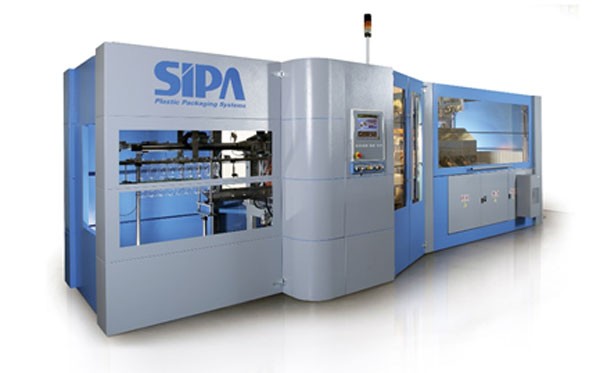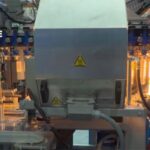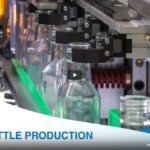The SFL FLEX is a linear blow molding machine that can be equipped with one or two blow cavities and can produce a wide range of containers.
The machine’s FLEX design allows for easy conversion from two cavities to a single cavity and vice versa. The SFL FLEX can also be configured as a single-cavity version.
The platform can produce standard and customized bottles for ambient and hot filling, oval containers with oriented necks, multilayer bottles, colored bottles, lightweight bottles, and small containers for the pharmaceutical industry, as well as large containers up to 5 liters at high productivity.
Preform handling system:
Preforms for industrial bottle production are unloaded in bulk from the transport boxes into the preform hopper; an optional tipper for standard and special cartons is available.
The preforms are then moved from the hopper via an elevator belt to the aligner. This alignment system is located at a higher position than the blowing wheel and ovens to ensure uniform preform delivery.
The preforms are aligned by gravity via two rotating cylinders with their necks facing upwards and are prepared to slide into the machine via a width-adjustable chute located inside the safety cabin.
Preform Transfer and Thermal Conditioning
From the feeding chute, the preforms are loaded onto the conveyor belt via a gripperless loading wheel. The platen gradually slides into the preform’s neck via a spring that is released by a mechanical cam.
During the heating phase, the preforms rotate continuously for perfect symmetrical heat distribution. The ovens are ventilated to keep the internal temperature of the preforms low, thus preventing excessive heating of their outer walls. The ovens are modular, allowing them to be integrated into various models based on heating needs.
The preforms transported into each oven pass past eight (8) infrared lamps on one side and vertically slit mirrors on the other. The air passes over the preforms perpendicular to their axis, having been drawn in by centrifugal fans with controllable speed from the lower part of the ovens in the following order: first through the mirrors, then through the preforms and the lamps, and finally completely drawn out at the upper part of the ovens.
To heat special preforms, ovens with additional lamps (9° and 10°), with reduced lamp pitch, or with higher intensity lamps are available as options.
The preforms pass through two or three ovens, allowing adequate time for the preform temperature to equilibrate and stabilize across the preform wall.
At the exit of the last oven, the preforms are transferred to the blowing station using a variable-pitch system driven by a servomotor. This system is capable of combining the continuous movement of the oven area with the intermittent movement of the blowing press.
Stretch-Blow
The stretch and blow phases are performed inside a fully servo-driven blow molding machine. The mold is installed with one or two cavities, depending on the maximum bottle size to be produced. The servomotor allows the press to operate with different strokes, which can be set on the HMI, to maximize process time.
The axial stretching of the preforms is performed by rods that move together, driven by a servomotor, to achieve maximum repeatability and consistency of the blow molding process. The subsequent low-pressure air pre-blowing and high-pressure air blowing actions are regulated by pneumatic valves (electronically operated). The blowing parameters stored in the production recipes ensure rapid, precise, and repetitive setting of the blow molding process.
During the high-pressure blow molding process, the mold opening is inhibited by adequate compensation using the same high-pressure air.
Bottle Ejection
At the end of the blow molding process, when the air is exhausted, the blow mold opens to release the blown bottles. These bottles are then unloaded by a linear transfer system, which is mechanically integrated with the blow molding machine.
The machine can optionally be equipped with a downstream unloading system based on specific customer requirements (conveyor belt, air conveyor, etc.).
Control Software
The human-machine interface (HMI) consists of an industrial PC. It monitors the machine’s performance, but
It also manages all preform heating/blowing parameters: they are saved in the internal memory, ensuring each container produced has its own configuration.
It manages all process and operating parameters and generates production, performance, and warning/alarm reports, and enables remote control operations.
The HMI also monitors and recommends machine maintenance activities.
All process parameters for preform heating and bottle blowing can be modified via the HMI and can be stored in the machine’s UPS, even in the event of a power outage.
Air Recirculation System (ARS®)
The optional ARS® system recovers the air emitted from each cavity in a dedicated tank (integrated into the machine) and recirculates it as needed (pre-blown air, service air, etc.).
ARS+® recovers significantly more air in two different tanks: the first (low pressure) is used for pre-blowing, the second (medium pressure) for intermediate blowing, before the final high-pressure blowing. For this reason, the compressor only needs to supply the final air requirement (18-28 bar). Both of these systems are optional.



